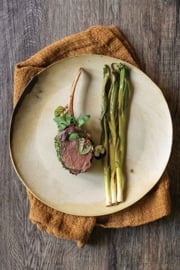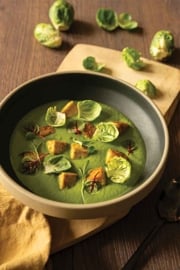
When freshly sliced, queso fresco is mild and somewhat bland in flavour; when melted, it puffs into marshmallow-like pillows with a buttery, nutty taste that will awaken your umami taste buds. The texture can vary depending on how much weight is applied to the cheese when it’s set.
Key queso fresco ingredients
Rennet is used to form a solid, consistent curd. The curd mass created when using rennet looks like a gentle milk panna cotta. Traditionally, animal rennet is used in cheese making. Vegetable rennet, created from thistles or certain fungi, is also available.
Calcium chloride isn’t necessary if using raw milk, but it’s an important addition to non-homogenized milk, as pasteurization removes calcium. Reintroducing calcium chloride into the milk will aid curd formation.
What’s a cheese curd knife?
A cheese curd knife is a long, narrow tool with a thin, flat blade. You can also use a cake-decorating spatula, though it must be long enough to reach the bottom of the pot without its handle touching the curd.
What in the world is queso fresco?
Queso fresco means “fresh cheese” in Spanish and is the most widely used cheese in Mexican cooking. The recent influence of Mexican cuisine upon our Canadian palate has become as integral to our culinary scene as Chinese food and Italian food. Queso fresco is a white cheese with a firm texture and mild, slightly tangy taste. This high-moisture cheese is delicious fresh and easy to make. Once you’ve made it, you can dramatically alter the taste via additional ingredients such as dry herbs and vegetables, spices, and honey.
Typically, when we think of cheese, we think of fatty food. Most health-conscious eaters limit their cheese intake considerably due to that sweeping belief. A wide range of minerals and vitamins are found in queso fresco, as well as linoleic acid, which may actually aid in burning fat—fancy that. Like other fresh cheeses, queso fresco is lower in fat and sodium than aged cheeses.
How to use queso fresco
Crumbled, grated, sliced, or melted, queso fresco can offset the heat in traditional Mexican cooking. When freshly crumbled, it adds texture and milky goodness to salads and fruit. Although it’s scrumptious hot, queso fresco doesn’t melt in the traditional cheesy fashion. Instead, it softens into puffy little pillows of molten milkiness.
Queso fresco tasting notes
Taste and smell: mild, fresh, gentle milky aroma
Texture: smooth, creamy, and granular
Versatility: excellent crumbled, cubed, melted, or shredded
Homemade Queso Fresco
Ingredients
- 16 cups (4 L) good quality whole milk
- 2 to 3 Tbsp (30 to 45 mL) buttermilk
- 1/4 cup (60 mL) non-chlorinated water, divided
- 1/8 tsp (0.5 mL) calcium chloride, diluted in 2 Tbsp (30 mL) non-chlorinated water
- 1/8 tsp (0.5 mL) liquid rennet, diluted in 2 Tbsp (30 mL) non-chlorinated water (dry also works)
- 2 1/4 Tsp (10 + 1 mL) kosher cheese salt
Nutrition
Per serving:
- calories299
- protein18g
- fat24g
- saturated fat13g
- trans fat0g
- carbohydrates3g
- sugars2g
- fibre0g
- sodium751mg
Directions
01
In large nonreactive stockpot, heat milk gradually to 90 F (32 C). Stir occasionally and use a kitchen thermometer to read temperature; this will take about 20 minutes. Turn off heat. Add buttermilk and incorporate using slotted spoon, making 20 up and down circular strokes through milk.
02
Cover and let sit for 30 to 45 minutes to ripen milk while maintaining temperature. Add diluted calcium chloride solution using 20 up and down circular strokes through milk. Add diluted rennet; incorporate the same way. Cover pot and let sit for 45 to 60 minutes, or until a clean break is achieved. (A clean break is when you cut the curd, lift it up, and it breaks in one clean gelatinous slice, with whey oozing into it.)
03
Using cheese curd knife, cut curd into 1/4 in (0.6 cm) squares. Let rest for 10 minutes. Return pot to heat, gradually increasing temperature to 95 F (35 C), stirring occasionally; this may take about 20 minutes. Maintaining temperature, let rest for 10 minutes. Ladle off whey to expose curds.
04
Remove from heat. Gently ladle curds into cheesecloth-lined colander. Let drain for 5 minutes, sprinkle salt directly on curd, and gently combine by hand.
05
Gather 4 corners of cheesecloth and tie together to form a bag. Place bag between 2 cutting boards. Place 8 lb (4 kg) weight on top, and press for 3 hours over large food-safe basin (or sink) at room temperature to catch whey as it expels from curd. Flip, and press for another 3 hours.
06
Unwrap cheese and taste! Itu2019s ready to eat immediately and can be stored in airtight container for up to 3 weeks in refrigerator.




